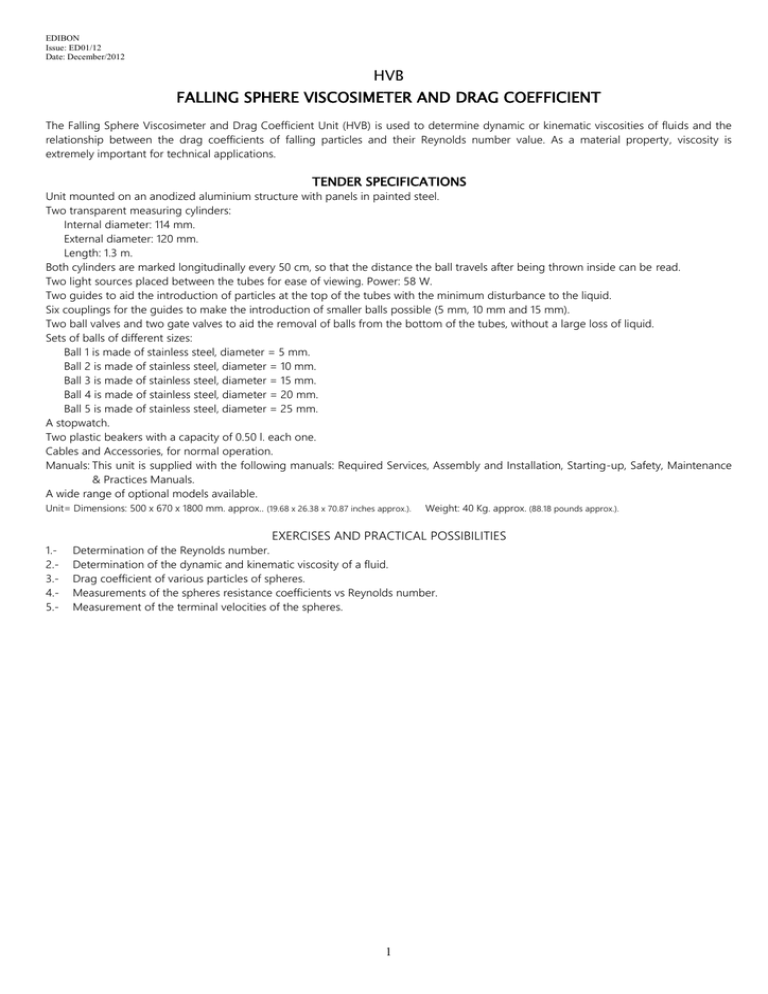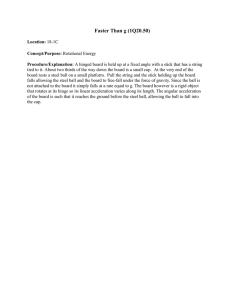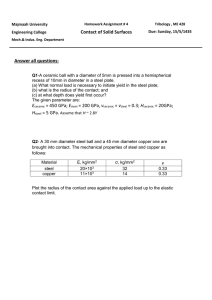HVB FALLING SPHERE VISCOSIMETER AND DRAG COEFFICIENT
advertisement

EDIBON Issue: ED01/12 Date: December/2012 HVB FALLING SPHERE VISCOSIMETER AND DRAG COEFFICIENT The Falling Sphere Viscosimeter and Drag Coefficient Unit (HVB) is used to determine dynamic or kinematic viscosities of fluids and the relationship between the drag coefficients of falling particles and their Reynolds number value. As a material property, viscosity is extremely important for technical applications. TENDER SPECIFICATIONS Unit mounted on an anodized aluminium structure with panels in painted steel. Two transparent measuring cylinders: Internal diameter: 114 mm. External diameter: 120 mm. Length: 1.3 m. Both cylinders are marked longitudinally every 50 cm, so that the distance the ball travels after being thrown inside can be read. Two light sources placed between the tubes for ease of viewing. Power: 58 W. Two guides to aid the introduction of particles at the top of the tubes with the minimum disturbance to the liquid. Six couplings for the guides to make the introduction of smaller balls possible (5 mm, 10 mm and 15 mm). Two ball valves and two gate valves to aid the removal of balls from the bottom of the tubes, without a large loss of liquid. Sets of balls of different sizes: Ball 1 is made of stainless steel, diameter = 5 mm. Ball 2 is made of stainless steel, diameter = 10 mm. Ball 3 is made of stainless steel, diameter = 15 mm. Ball 4 is made of stainless steel, diameter = 20 mm. Ball 5 is made of stainless steel, diameter = 25 mm. A stopwatch. Two plastic beakers with a capacity of 0.50 l. each one. Cables and Accessories, for normal operation. Manuals: This unit is supplied with the following manuals: Required Services, Assembly and Installation, Starting-up, Safety, Maintenance & Practices Manuals. A wide range of optional models available. Unit= Dimensions: 500 x 670 x 1800 mm. approx.. (19.68 x 26.38 x 70.87 inches approx.). Weight: 40 Kg. approx. (88.18 pounds approx.). EXERCISES AND PRACTICAL POSSIBILITIES 1.2.3.4.5.- Determination of the Reynolds number. Determination of the dynamic and kinematic viscosity of a fluid. Drag coefficient of various particles of spheres. Measurements of the spheres resistance coefficients vs Reynolds number. Measurement of the terminal velocities of the spheres. 1



